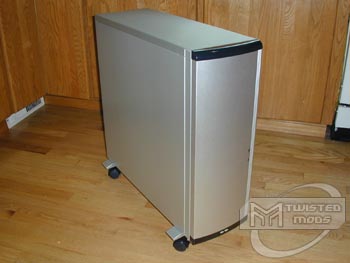
It has certainly been a while since I?ve reviewed a chassis, and following my review on the U2-UFO chassis, I didn?t think that a case could possibly be any better ? even if it had wings, and the ability to take flight. To my surprise, after asking Lian-Li directly for a new case to review, they assured me that I would be impressed with what they had to offer. So I waited day and night by my front door until it arrived. Ok, no I didn?t, but I really was both excited and anxious to see what they had coming out next. Since I didn?t have the patience to wait until I had possession of it, I did request a couple quick pictures of the chassis. It looked like one of their normal server cases, but little did I know that this would be nothing like their previous line of cases up close and personal. When I received the chassis, I quickly busted through the box with my knife and dug in!
When it comes time for me to pick my next personal chassis/Dremel victim, I base my decision primarily on the material with which the chassis is built. While most companies still build steel cases, Lian-Li is still one of the few manufacturers always has and always will use ONLY aluminum; probably because of its thermal properties, light weight, and natural appearance. Unlike plastic or steel, aluminum has the ability to look absolutely gorgeous without paint, sanding, bondo, pin striping, or whatever else you may think of. Just a simple clear anodizing to protect the surface plus a ?brushed? look makes aluminum look wonderful. Although brushed aluminum can make any old 400 MHz hunk of junk look ?cherry,? with all quality products comes a hefty price; even scrap aluminum is expensive compared to boring old steel. In addition to good looks, however, aluminum has the advantage of better heat dissipation than steel. Steel has a tendency to hold heat in the metal, while aluminum will transfer heat through the metal, almost as if it were a heatsink. This property in itself wins many case buyers? votes, but you can?t rely solely on the aluminum to do the work. A lot of the cooling in any case has to do with fan placement, which is what I look for next in a chassis. If the case has adequate cooling for the system I will be putting inside, and some kind of physical attraction or potential to look pretty with some craftsmanship, I usually choose the case right there. Keeping this in mind, let?s get on with this review of Lian-Li?s newest addition to their case lineup ? the Lian-Li PC-73SL. TwistedMods is the only site to review this case, so we?re going to do our best to help you figure out if this case meets your needs!

The most beautiful side on this chassis is by far the front. If you have known me at all in the past, you know that I am a die hard fan of any case with a door. Not only does it give the front of the case a cleaner look by hiding the drives, people who do not like to paint their drives simply don?t have to, because the door is closed 90% of the time anyways! Not only this, but a front door gives me something more to which I can apply my Dremel and my imagination. With a door, you have the option of cutting out a symbol and putting lighting behind it, which looks absolutely fantastic. Other options include laser-etching the door or even lighting behind the door without a window to give the case a glowing effect. Doors make the possibilities and complexity of a case so much better! The front of this Lian-Li PC-73SL has a full height door made from very thick aluminum, curved to provide more ?depth? than a normal boring square front. The curve in the front door is not too convex, and matches perfectly with the style of the case and the ?carbon fiber? style plastic pieces located just above and below the door. These also have a beveled edge, giving the case even more depth ? something that a lot of aluminum case manufacturers can?t do without a full plastic front panel. The power and hard drive LEDs, midway down the right side of the aluminum front door, are piped through to be visible even when the door is closed. This is not unusual, but it comes in helpful when you don?t want to open the door to see if the hard drive is being accessed.
While writing this review, I discovered one thing that the front of the PC-73SL seems to be missing ? a lock! I?ve noticed that a majority of the Lian-Li server cases today include a keyed locking mechanism on the front door, however, this case does not. This could pose potential security issues for some users wishing to lock their valuable systems during overnight LAN parties. I also noticed that the vent holes in the front door seem to be gone in this new chassis. Personally, I think this is a GREAT move on Lian-Li?s part; it gives the case a cleaner and more professional look instead of the busy look that case manufacturers seem to like these days. My only concern would be airflow - which I will cover a little later in this review.
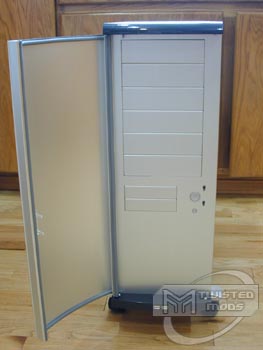 ?????
?????
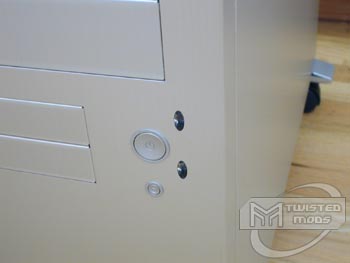
After popping open the front door using the ?lip? on the right side of the door, I was astonished by the beauty behind the door, too! I had been worried that I was going to be blinded by the ugly front seen in Lian-Li?s past server cases, where the fan filters are clearly visible and the drive covers are absolutely hideous (see Lian-Li?s PC-78). To my surprise, I noticed the front panel behind the door was just as clean and beautiful as the actual front door. The front panel reminds me of the size and layout of the PC-7, especially with the brushed aluminum drive bay covers which are used on all Lian-Li towers. Also missing from the front of the case, behind the door, are the front ventilation holes. Maybe Lian-Li has a trick up their sleeves somewhere, so I won?t go too in-depth on this just yet! The power and reset buttons used in this chassis are the same as all other Lian-Li?s, which are perfect no matter the size of your finger. While the power button is plenty big and matches the natural brushed aluminum nearly perfectly, pressing the reset button may require using the pinky finger for some. I am able to push the reset button with my index finger, although I do have small hands. To the right of the buttons, you can see the location of the power and hard drive LEDs which feed to the light pipes located on the back of the swinging front door. From the outside of the chassis, I am immediately able to see that the PC-73SL is capable of holding up to SIX 5.25? external devices, as well as a maximum of two 3.5? externally accessible devices. Once I tear open the side panel, I will be able to give a full count on the number of possible devices.
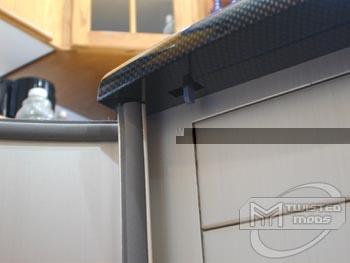 ?????
?????
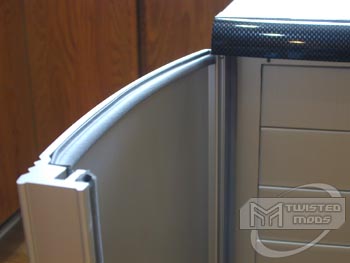
A quick look at the door from inside will reveal some of the attention to detail for which Lian-Li is known. In the first picture on the left, you can see that the front door on the PC-73SL is easily removed with the touch of this quick release tab. This light blue plastic tab is located on the upper carbon-fiber style plastic, and releases the top end of the front door when pressed to the left. Once the top end of the door is released, you simply lift the bottom end out, and you are good to go. You may choose to display your chassis with or without the door ? that is entirely up to you! Also (not pictured) on the right side of each of the plastic carbon fiber style pieces are spring loaded balls which hold the door closed and easily release when the door is tugged using the ?edge? on the right side. This will keep the door from flying all over the place during transportation.
Next, on the photo to the right, you can see that this case has a strange molding located just around the edge of the inside of the door. After contacting Lian-Li to confirm its purpose, I was told that this is to ?soundproof? CD-ROM/Floppy drive noise. Talk about attention to small detail; around each of the sides of the front door is this soundproof molding, and that would explain why there are no ventilation holes in the front door, either ? those would just be another way for noises to exit the case! Who would have ever thought that a Lian-Li server case would come stock with soundproofing?! I certainly didn?t, and we will see the rest of the case is also soundproof as we get to those parts.
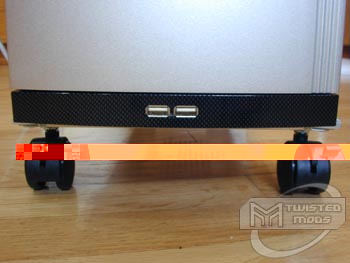
On the front of the bottom carbon-fiber plastic piece, two USB 1.1 or 2.0 compatible ports are flush-mounted ? to give the case even more convenience without requiring a USB hub or making you reach to the rear of the case to plug something in. These add a GREAT deal of functionality to the chassis, and they look great too. As a side note, the front door can be either closed or open while using the front two USB ports because they are not located within the front panel; they are accessible from outside the chassis.
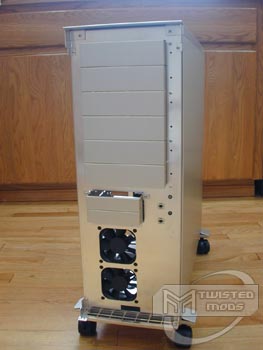 ?????
?????
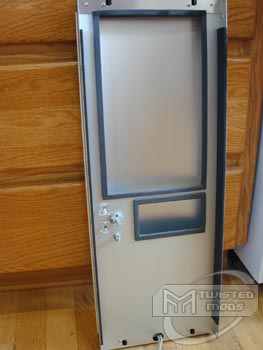
On older style Lian-Li towers, the front simply pulls off with a nice tug, but unlike most other Lian-Li cases, the PC-73SL requires a #1 Phillips screwdriver to remove. Seeing as this is a server chassis, using screws makes chassis construction a little more sturdy and reliable ? especially with that heavy front door! I would hate to roll this case from the car into a LAN and have the front door fall off because of a bumpy sidewalk! Having this beautiful brushed aluminum front door get gouged and scratched on concrete would certainly not make my day, and would completely ruin my experience at the LAN. To remove the front panel, simply remove the two screws on each side; four total. These are smaller screws, so be careful not to strip them out! After removing the four screws, I simply pulled the front panel away from the rest of the case and took a gander. Then I set the front panel aside and observed the front without the panel attached. It brought me to flashbacks of those ugly PC-78 cases, inside the front door! EWWW! Unfortunately, I also found out that the only way to remove the drive bay covers is to take the front panel off by removing the screws as I did, or by pulling the side panel off and using some force to push them out through the front of the case. Also by taking off the front panel, I was able to locate the TWO 80mm intake fans stacked vertically near the bottom of the chassis, as well as the bare power and reset buttons/LEDs. These two fans do not have fan grills, but when I looked just a little lower, I noticed a small fan filter about 1? tall by about 5? wide ? this tells me that air intake for this case is pulled in from beneath the front of the case, just like mid-towers back in the day. I am not especially fond of this cooling method because TWO 80mm fans running at full power are relying on a small filter to pull air into the case. That filter isn?t even located directly in front of them, and when that little filter gets clogged, there will be huge cooling issues. I would personally remove the two thumbscrews from the underside of the chassis and remove the fan grill completely. Sure, this increases the amount of dust being pulled into the case, but you also significantly increase the amount of airflow into the case. I would even consider having some sort of front fan hole put in the front panel directly in front of the fans, although this would obviously destroy any hopes for a silent pc. One last thing you will notice is the rectangular hole located just above the fan filter ? this hole is used to pass the cables from the front USB connectors through to the motherboard on the back end.
When removing the front panel, be careful not to just rip it off, especially when there is a system inside. Just as I was going to replace the front and screw it back into place, I noticed more black soundproof molding located around the holes cut for the 5.25? and 3.5? devices on the back of the front panel. You can see this in the picture above on the right. You can also see the black molding located around the edges of the front panel. When I saw all of this, I nearly dropped dead. I could not believe that a case manufacturer would pay such close attention to such small details. This shows a ton of dedication on Lian-Li?s part to ensure that their cases are, in fact, soundproof.
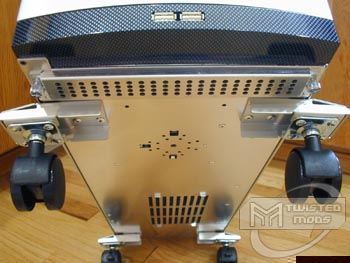
Never have I reviewed a case with so many features in just the front! Let?s move along to the bottom of the case, finally! This is a great shot of the bottom of the PC-73SL chassis. Since this case stands a total of 22.5? tall and just 8.5? wide, you can see that tipping may be a concern for the owner of the expensive server components inside. Taking this into account, Lian-Li has mounted four casters to the bottom of the case, which widen the base by 1.5? total on each side. This will help prevent any top-heavy systems from falling over too easily by giving the case a total width of about 11.5? but also raising it to a height of 25.5?. The mounts for the casters in each corner of the case are also constructed of brushed aluminum, keeping the building materials consistent on this chassis. Each caster is riveted directly into the bottom panel of the case with four rivets, so you won?t ever have to worry about casters falling off through the life of the chassis. You will also notice that each of the four casters has a lock ? an important feature. If your server is placed on a table or anything higher than ground level, having full locking casters is a MUST. I would hate to see my server fall off of a table ? in fact, I think I would cry. To lock each of the casters, simply press down with your foot on the little tab on top of each wheel. To unlock, just pull the tab back up out of the locked position.
On the bottom of the case, you can see a closer picture of the front fan filter held in place with two thumbscrews. While this is a great idea, and adds a clean look to the front without ventilation holes, a constant cleaning on this front filter is absolutely necessary to maintain good intake airflow. Located also on the bottom panel of this case is a series of ?slits? for another fan on the inside of the case as intake as well. The casters raising the case off the ground play a HUGE part in this case?s cooling capability. If the case was placed directly on a surface such as carpet, there would be virtually no airflow because both the front and rear intake holes would be blocked, leaving no way for air to enter the case. Intake would be impossible on this case without casters, plus the convenience of rolling around an aluminum case filled with thousands of dollars worth the components is indescribable.
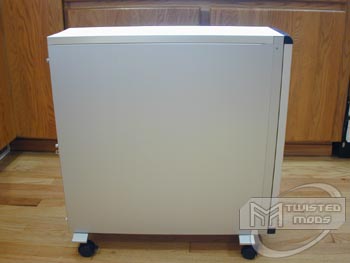
Moving around to the side, there really isn?t much to see, as a lot of the goodies are hidden inside the case. From this shot, you can see that the side panel is just a plain ol? piece of brushed aluminum. This chassis has no handle indentations, pre-cut windows, or anything else like that. This is nice, since it leaves PLENTY of space for you, the modder, to create any design you see fit. Each of the side panels is fastened by three chrome-like thumbscrews, with the option of a padlock for those who wish to keep their hardware from being stolen. To remove a side panel, simply unscrew the three thumbscrews and slide it towards the rear of the case ? then pull it upward and it will come free. There?s nothing special about the top panel of the PC-73SL either, it?s a natural brushed aluminum, just like the rest of the case, with no blowholes, indentations, or other markings. To remove the top panel, you would need to drill out the rivets holding it in place, which is not recommended (there?s a reason they put rivets in there) and the top would lift straight off. This picture also shows you the actual depth of the case. From the rear of the case to the front swinging door, this case is exactly 24? (two feet) deep. This case is probably perfect for fitting under any desk you may use without sticking out and getting kicked (which is always wonderful) if you don?t plan on putting it in some sort of server room. Who would want to hide this case though? As beautiful as it is, I?d use it for my home PC and put it on top of my desk. :)
Next Page 2/2 >

